I’ve always been interested in coaching some day.
I’m not sure when that day will be.
I’ve played soccer since junior high, and thankfully my 29-year-old legs are still good enough to get me through 90 minutes in the Casa Soccer League on Saturday afternoons. I’m also privileged enough to write about soccer, but I’d love to be able to teach the game when I finally retire from local rec leagues and pickup games.
Now, if you want to go out and coach your six-year-old daughter’s youth team, you probably don’t need a license.
But other organizations do require a license, and if you’re serious about it, you can take courses that give you full instruction from already-established coaches.
Complete the course, and you get your certification.
The program is run by U.S. Soccer, but it begins at the state level. So, if you live in Philadelphia, like myself, the courses are administered by Eastern Pennsylvania Youth Soccer, which you probably know as EPYSA. There are different levels of licensing, beginning at “E” and going all the way up to “A”.
My story begins at the “E” level.
Friday, April 4
This course spans three days and 18 hours. There’s a Friday evening session, followed by two full days of instruction on Saturday and Sunday. Finding a weekend to dedicate to the class is a pretty significant commitment, especially if you’re already working full-time or weekend hours.
My class is in Bucks County at the community center just off of Street Road in Southampton. It’s a nice little joint. There’s a lobby with a welcome desk and a few vending machines adjacent to an indoor basketball court on my left. We’re meeting in a smaller room to the right.
The first class starts at 6 p.m., and I show up at 6:02 p.m. It takes me an hour to drive from Port Richmond to Southampton, in the rain, in rush hour traffic.
There are five folding tables to accommodate the 14 people in our class. Our instructor is Don Brady, and he’s been coaching for longer than I’ve been alive. Don is an A-licensed coach with a master’s degree and 33 years of experience. He’s spent the last 18 coaching high school boys at Central Bucks South, and he also coaches girls in the “Olympic Development Program”, which is tied to U.S. Soccer and serves to identify select players for inclusion at various national team levels.
Long story short, Don has done pretty much everything over the last three decades.
He’s got a laptop computer projecting the E-license guidebook onto a pull-down screen at the front of the room. But before we get into the slides, our first assignment is to partner up with another classmate, learn about them, and then tell their story to the rest of the group.
I’m sitting next to a young woman named Ashley. She’s probably in her mid-twenties, a former college player at Seton Hall University and a north Jersey native. She played semi-pro soccer in England, but she wants to take the E-license course because she’s found an assistant coaching job with Clayton State University, a small college about 15 miles south of Atlanta, Georgia.
It’s a diverse group inside the community center. Raphael is 23 years old, and he’s from Greece. Like myself, he’s on the younger side of the group, with no coaching experience whatsoever.
On the other hand, Pat Casey has been coaching at Fox Chase Soccer Club for the last 10 years. Another classmate, Brett, coaches U9 girls for Parkwood, which is just outside of Northeast Philadelphia. There are a number of classmates who already have coaching experience at the youth level, but they’re here to earn the E-license and learn how they can improve as instructors.
“It’s for my boys, you know?” Pat told me.
He explained that he was here to better his coaching and learn more about the game.
I’d find out later that he’s already pretty good.
But let me backtrack for a moment.
I had to prepare a few different things before the class even started. First, there are three online programs to complete. Two involve basic rules of the game, and the third is a course about concussion protocol. You finish these exercises, print out the certificates of completion, and bring them to class.
The other prerequisite material is a pair of essays. Piece of cake for a writer, yeah? I whipped up two pages on my “personal coaching philosophy” and answered a separate series of basic questions.
Back to the classroom —
Don takes us through the slides, and we talk about the four components of long-term athletic development: technical, physical, tactical, and psychosocial. The discussion is engaging and bright. The experienced coaches are dropping knowledge left and right, and I invoke my experience with the Philadelphia Union to mask the fact that I’ve never worked with a nine-year-old kid.
We spend a good bit of time talking about the U9 to U12 curriculum and how training sessions generally progress through four “stages”.
This is a theme reiterated throughout the weekend.
Stage 1 is a warm-up exercise: Get the blood flowing, get your players going. Stage 2 is a small-sided activity, with emphasis mostly on technical skill. Stage 3 expands that activity, and Stage 4 is a full-fledged training game or scrimmage.
Throughout the weekend, we will be learning activities to fit these various stages, which we’ll then present to the rest of the class.
My topic for teaching is “redirecting serves to go forward.”
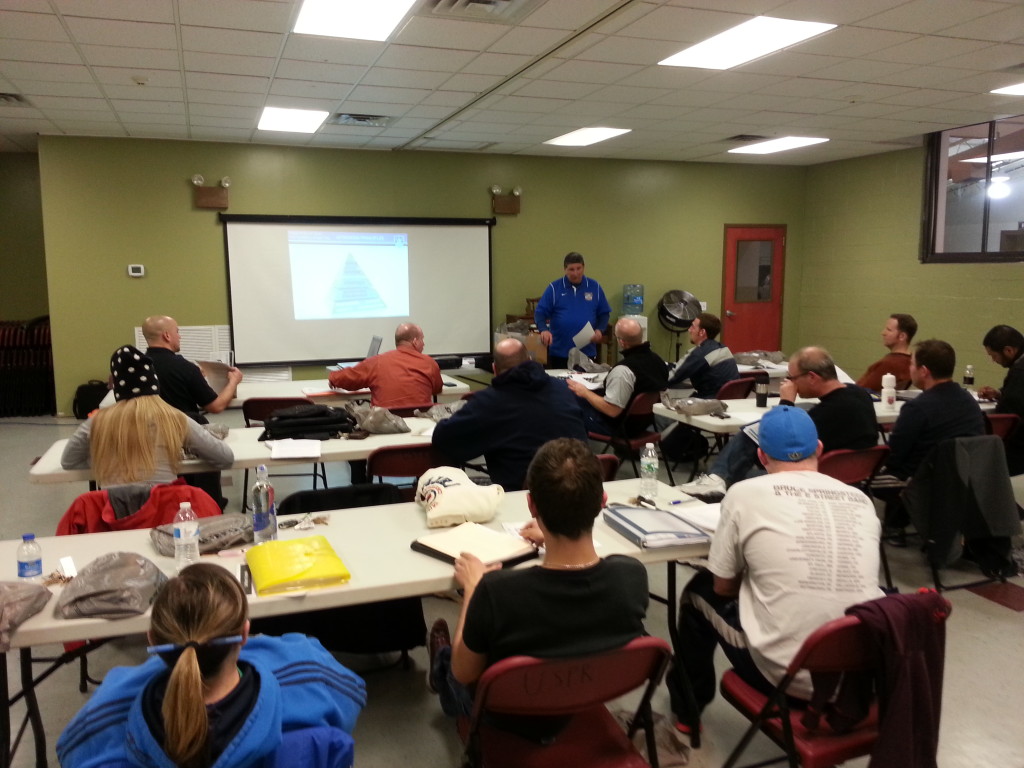
Instructor Don Brady takes us through the “E” license guidebook inside the Southampton Community Center. Don has an “A” level license and 33 years of coaching experience.
Saturday, April 5
We’re back in the classroom at 8:30 on Saturday morning.
This is difficult for me.
I’m a second-shift worker, and I usually don’t even wake up until 9 a.m. on most days. One of the other guys in our class is up by 3 a.m. Monday through Friday and prefers to start at 6 a.m. He actually lobbies us for a crack-of-dawn starting time, which is pretty easily shot down by the rest of the group.
We finish up another set of slides before heading outside to Veterans Field, which is right off Street Road about three minutes away. It’s cold, windy, wet, and overall pretty miserable outside. On a normal Saturday morning, I’d just be waking up, pouring a bowl of cereal, and sitting down on my (roommate’s) couch to watch English Premier League.
We’re joined today by the charismatic and engaging Antonio Bayon. Antonio is also an A-licensed coach and a native of Valladolid, Spain, which is about an hour north of Madrid. He actually played for Valladolid’s youth team and dropped out of high school during his playing days. Eventually, he met his wife, moved to the United States, and got a master’s degree in engineering.
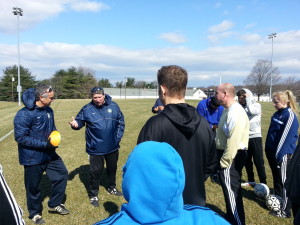
Don explains the importance of keeping your players active and involved during drills. It was cold, wet, and windy on Saturday morning.
“Land of opportunity, for sure!” he exclaims.
We split into two groups, and Antonio and Don introduce some very basic drills that we can teach our players. Antonio takes us through offensive movements, going over a variety of 1-v-1 situations that emphasize beating a defender and dribbling beyond the play. We add to the drill incrementally, telling the defenders to up their pressure, expanding the playing field, and introducing passing elements.
Don is working on defense on the other side of the field. He takes us through similar 1-v-1 drills, where we shield the ball from an opponent and attempt to win and keep possession in various situations. You get the sense that he’s a more defensive-minded guy while Antonio brings some of that Spanish attacking flair to his lessons.
We return to the classroom to finish up our guidebook part of the course, but not before going through some goalkeeper activities. I have to say, it’s a little weird watching 50-year-old men crawling around on the ground, but the goalie exercises are both practical and entertaining at the same time.
It’s a short lunch break and we’re going back outside to Veterans Field. Don tells us that we have to fold up the tables and chairs inside the community center because there’s a “Zumba” dancing class coming in shortly.
The second part of Saturday is when we become the teachers.
Again we’re split into two groups, half of us with Antonio, and the other half with Don. I’m in Antonio’s group, and my job is to take the rest of my classmates through a stage two exercise on my “redirecting serves to go forward” topic. Antonio will watch and take notes.
I section off an area and create a 3-v-2 situation with yellow-clad attackers outnumbering orange defenders. There is a sixth player, wearing a blue jersey, who functions as our “target.” The idea of the game, I explain, is that you must pass it to the person in blue before you can move into his area and get forward. He’s our attacking pivot, and I want them to play to him for a layoff or redirection forward.
We spend about 10 minutes running the drill, and it goes pretty well. We regroup to talk about it, and Antonio seems pleased with the concept. He suggests that I can expand the drill and get the “target” more involved by allowing them to drop into the zone and look for the ball. This way, the child I’m coaching is a little less “static,” and more involved in the drill.
Mind you, there are no kids out here, so we’re the guinea pigs in these demonstrations. I’m still in my twenties, so I feel comfortable running all the drills. Some of the older guys in our group are a bit more “labored” as they go through the exercises, but you have to give them a lot of credit for putting in the physical work in addition to learning and observing at the same time.
“Now you have an appreciation of what your players have to go through,” Don says. “Obviously if you don’t have the playing background, it’s a little more difficult, more challenging. All of us are getting older and you need that fitness level to play. But it’s not that overwhelming, I don’t think.”
Everyone finishes up their stage two drills, and we’re done for the day.
Well, most of us are.
I’ve got a Casa League game at 5:45, so I hop on the Pennsylvania Turnpike and drive over to Wayne to play a full game on the turf. I’ve got the Union and Fire game on the DVR for later viewing.
Between the coaching course, my own game, and the Union game, I probably spent 15 hours dealing with soccer on Saturday.
Sunday, April 6
We spend the entirety of our final day outside. It’s not as cold as it was yesterday, but after those 90 minutes at center back (we won 3-2), my legs are pretty much done.
Sunday belongs to us aspiring coaches. My job for the day is to teach the rest of the class the stage three version of the topic I’ve spent the weekend working on.
Don takes us through warm-up drills that we can do with our youth players. We go over the basics, like quad and hamstring stretches, hip flexor and lunge exercises, and things like that. Most of our stretching and warming-up is done in a “mobile” fashion. We aren’t static when we stretch, and Don explains that the modern trend is incorporating movement and activity into stretching.
Now that the blood is flowing, it’s our turn to teach.
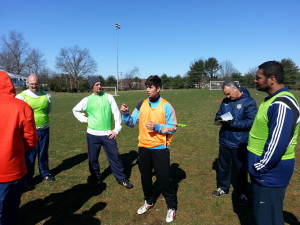
Rafael explains his “stage 3” exercise to the class. Antonio jots down notes that will go into Rafael’s evaluation.
Ashley expands on her topic, which is “aerial service into the box,” by adding more players to the field. She’s got a 4v4 in the middle of the area, with extra people running in the channels. The purpose here is to play to your wide teammates, who will then cross the ball back into the area.
Pat has a drill that combines passing, vision, and movement. He sets up several “gates” throughout the area and you score points by passing to a teammate through the gates. He’s pretty vocal, and even scolds me for trying to take on three defenders at once.
My exercise starts with a 3-v-3 in the middle of the field, with each team working off a pivot player and two goalkeepers at opposite ends. I’m serving in 50/50 balls that the players must win and play to the pivot. I explain to them that they can’t enter the final third until they get the ball to their target man, and only then can they shoot on goal.
Again, the drill goes over pretty well.
The rest of the class goes to another exercise, and I stay behind to discuss with Antonio. He asks me if I’m happy with it, and I explain that I would have preferred to play 4-v-4 inside the box instead of 3-v-3. He suggests removing the goalkeepers and allowing the target players free movement around the field.
This makes sense to me.
I’ve been focusing the drill on the “target” player, sort of treating that person like a hold-up striker or a big-bodied center forward. But Antonio explains to me that I can use that person in any fashion. Maybe the target is an attacking midfielder. If so, we can get the ball to his feet in deeper positions.
It’s all about keeping your players involved in the drills, especially if you’re coaching nine to 12-year-old kids.
One thing I notice about both Antonio and Don is that they spend quality individual time with their “students.” When I ask them about their involvement with the course, they both start their answer with the same three words: “I love it.”
“I coach at many levels, but coaching the coaches is one of the most rewarding (things) and some of the most fun I’ve had in this career,” Antonio explains. “The fact that the candidates give us 18 hours of their weekend to be with us, we know that they’re coming here to learn, and we expect them to learn, but there’s also a lot of quality. We get college players, who are very good. We also get the typical mom and dad, where they just want to get involved. It’s a huge, diverse spectrum.”
“This isn’t just coaching from the seat of your pants,” Don adds. “We’re all here to develop as coaches, to help the players develop. Sure, we can all go out and do drills, but do we know why we’re doing it? I appreciate the person who’s willing to research and to find those exercises, but also to know why they’re doing it, and how they’re implementing it, and whether or not they are really helping players to get better.”
We take a team picture, say our goodbyes, and hit the road as newly licensed youth soccer coaches.

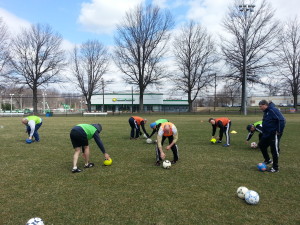
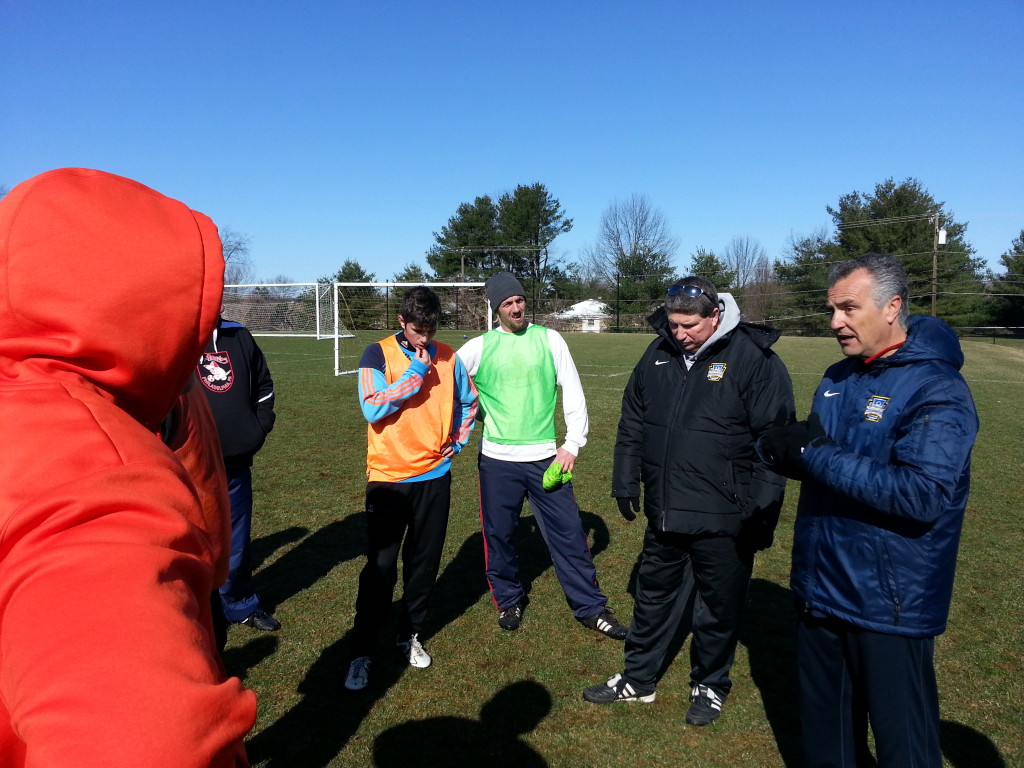
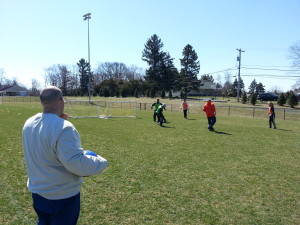
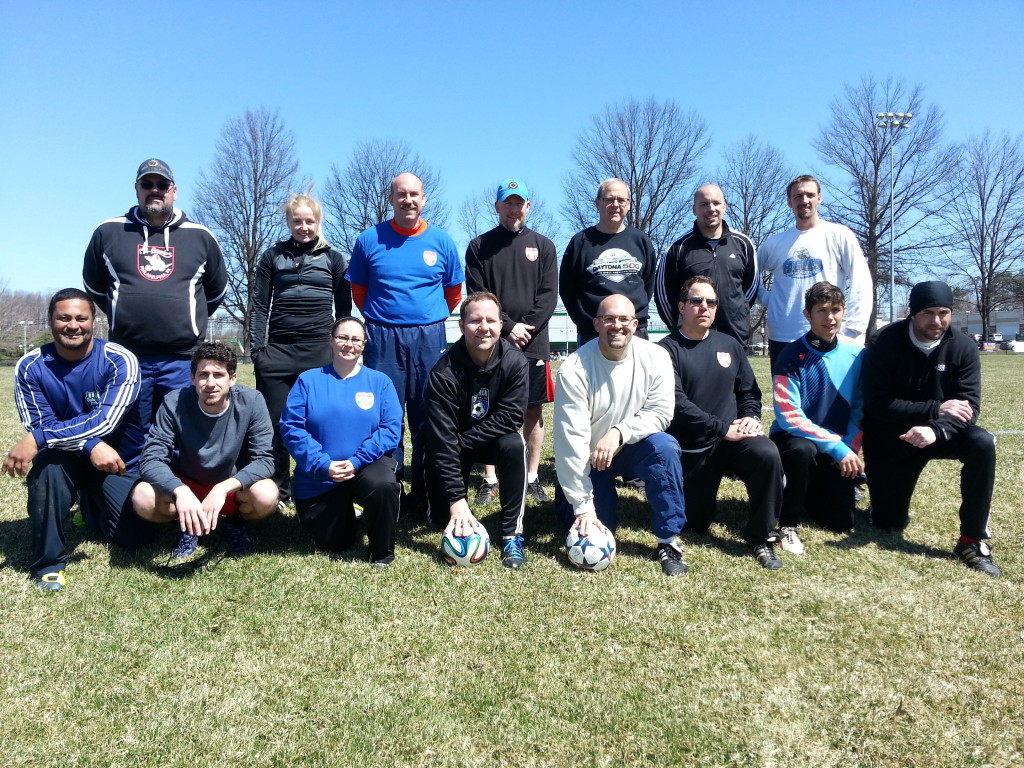

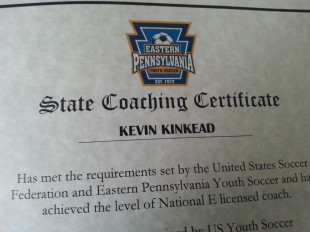

Hello Kevin.
.
Funny this article from you arrives as it does. I am scheduled to sit for National E in June and was curious what to expect from the commitment. Thanks.
.
btw, the 3-5-2 and wingback thing is great. Juventus make it look so so easy. Anything but easy.
It’s a healthy commitment, but I’d say it was definitely worth the time.
I think anybody can figure out basic drills, and come up with practice and progression plans for their kids. But learning the U.S. soccer structure and becoming familiar with the system and the terminology was something new.
Just be ready to do a lot of running and a lot of work, because you’re the one demonstrating the lessons.
Indeed.
Indeed. The timing is pretty interesting. I’ve been pondering this; I’ve been helping coach my kids since U8. I have a ton of fun with it, but they’re old enough now that I either need to evolve and improve, or get out of the way. So thanks for the peek inside.
this is awesome, and on my list of to-dos in the next couple of years.
Awesome! Welcome to the coaching “club”.
Great read, and a nice testimonial to the process.
Also enjoyed your contribution on the podcast this week and hope you join it as regularly as these other commitments allow.
Thanks, appreciate that.
One thing I should add:
You’ll diagram the exercises that you’ll present to the class on Saturday and Sunday. So, on Friday night, you’ll show up, turn in your written assignments, and then they’ll give you a topic to work on for the weekend.
I had to diagram my “redirecting serves to go forward” from stage 1 to stage 4, and then turn that in to the instructors.
You’ll have a very small homework assignment on Friday night, and then things are pretty straightforward on Saturday and Sunday.
I got my E license as well, this past December at Penncrest HS and some nearby fields. You definitely get a work out, and it wasn’t the best winter to be outside, but it was a great experience. The classroom segment was interesting for offering insight into the tactical and strategic aspects of the game, and the outside sessions give you plenty of good ideas to take back to your teams. Most importantly, you learn the concept of progression on a particular concept (as Kevin very well describes) and how important a well written practice plan can be. The evaluation piece is a little intimidating, but also a lot of fun. The class definitely changed the way I think about coaching.
Great insight into the process, Kevin. Enjoyed reading it.
Kevin,
Great article. Good description of the timeline. Told in such a way that the reader is right beside you in the classroom and on the field. KUDOS!
How much continuing education is involved once you gain licensure?
Continuing ed is only required for the USSF A licence.
A successful marketing strategy is dependent on the access of the customers.
If you do not have a very fast internet connection, it could take you several times longer to get the same amount of work done.
Years ago, when I walked to the flight line to take my first solo
flight in an F-15 fighter, I was struck by an all-encompassing passion that has driven me and everyone on my team to achieve success.
That a is a real nice story you have here. Unfortunately, I took the 1st half of the D license this weekend from the same instructors. Don Brady is a miserable excuse for a human being. He is out to fail anyone over 30 years old. It’s like that movie Logan’s Run.
My coder is trying to convince me to move to .net from PHP. I have always disliked the idea because of the costs. But he’s tryiong none the less. I’ve been using WordPress on numerous websites for about a year and am nervous about switching to another platform. I have heard good things about blogengine.net. Is there a way I can import all my wordpress content into it? Any kind of help would be greatly appreciated!|
Thank you for the breakdown of the course. Would you mind if I asked you about the essay portion of the course. I finished the Laws of the Game and Concussion portions, but am struggling with the essay. Normally a fair-decent writer, I can’t seem to even start the first sentence of this essay. Would it be too much to ask for a one-line starter idea? Thank you for your consideration